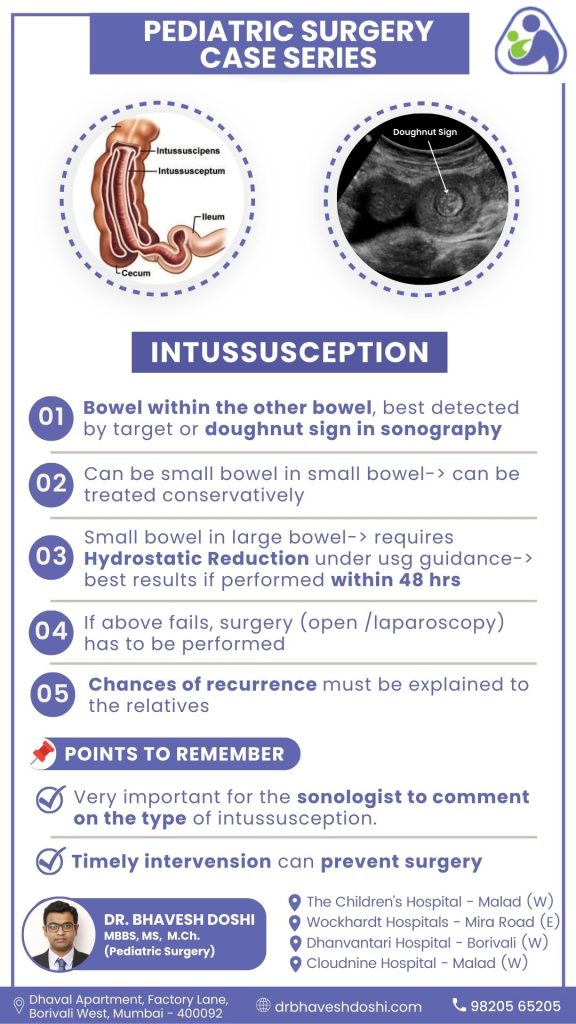Intussusception
Intussusception is a medical condition where a segment of the intestine folds into the adjacent section, typically affecting the small bowel and infrequently involving the large bowel. It causes symptoms like stomach pain, vomiting, bloating, and blood in stool. It can lead to a blockage in the small bowel, and there might be other issues like peritonitis or bowel perforation. This problem is more common in children, especially in boys, usually occurring between six to 18 months of age. It needs quick treatment due to the seriousness and possible complications.
How to diagnose intussusception?
Sonography and CT Imaging Features:
- The imaging appearance on transverse sonography or computed tomography (CT) reveals a doughnut shape.
- This shape is formed by the hyperechoic central core of the bowel and mesentery, surrounded by the hypoechoic outer edematous bowel.
- In longitudinal imaging, intussusception may present a sandwich-like appearance.
Abdominal X-ray:
- An abdominal X-ray may be necessary to assess for intestinal obstruction.
Air Enema for Diagnosis and Treatment:
- An air enema is employed for both diagnosing and treating intussusception.
- This procedure involves introducing air into the bowel to aid in diagnosis, and it can also serve as a therapeutic measure.

What are the Treatment options for intussusception?
Conservative Treatment for Small Bowel in Small Bowel
When intussusception is confined to the small bowel within the small bowel, a conservative approach is the initial choice. Conservative treatment implies a non-surgical strategy, often involving measures such as bowel rest, hydration, and close monitoring. This approach aims to allow the bowel to naturally correct itself without the need for invasive procedures.
Invasive Intervention for Small Bowel in Large Bowel
In cases where the intussusception involves the small bowel within the large bowel, a more aggressive approach may be necessary. This typically requires invasive intervention due to the increased complexity of the condition. The decision for more interventionist measures is made based on the specific characteristics and severity of the intussusception.
Hydrostatic Reduction under USG Guidance
Hydrostatic reduction, conducted under ultrasound (USG) guidance, is a preferred method for addressing intussusception. This procedure involves injecting a contrast agent or air into the bowel to push the telescoped segment back into its normal position. Best results are achieved when hydrostatic reduction is performed promptly, ideally within the first 48 hours of diagnosing the intussusception. The real-time imaging provided by ultrasound assists in accurately guiding the reduction procedure.
Surgical Options (Open/Laparoscopy)
If hydrostatic reduction proves unsuccessful or if there are complications, surgical intervention becomes necessary. The choice between open surgery and laparoscopy depends on factors such as the patient’s overall health and the severity of the intussusception. Open surgery involves a traditional incision, while laparoscopy is a minimally invasive approach that uses small incisions and a camera for visualization.
What are the Recurrence Risks associated with intussusception?
Timely intervention for intussusception is essential to prevent potential issues, such as perforation, bowel necrosis, and, rarely, short bowel syndrome. This is essential for relatives to comprehend the potential challenges associated with the condition and make informed decisions regarding follow-up care and monitoring.



